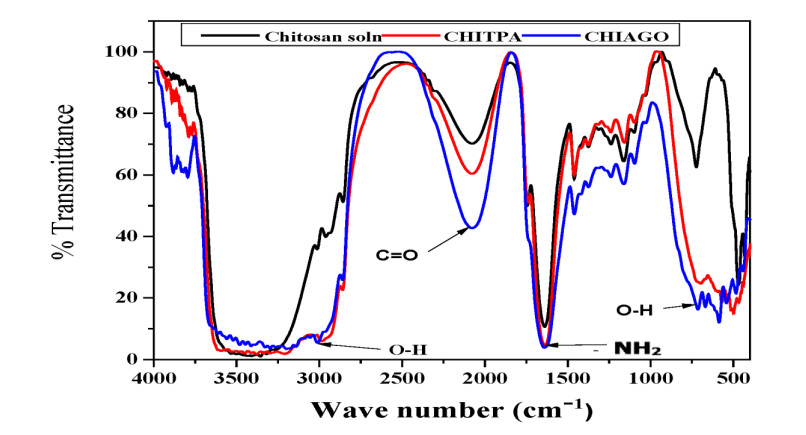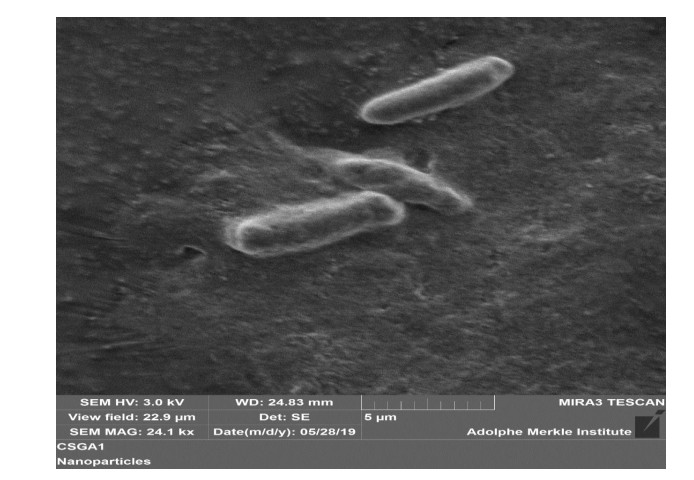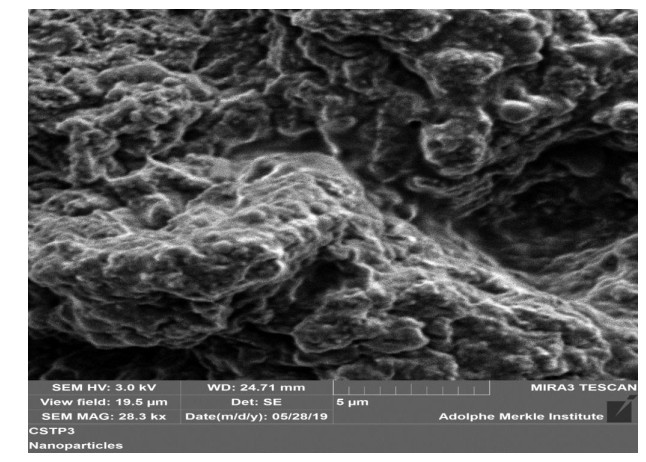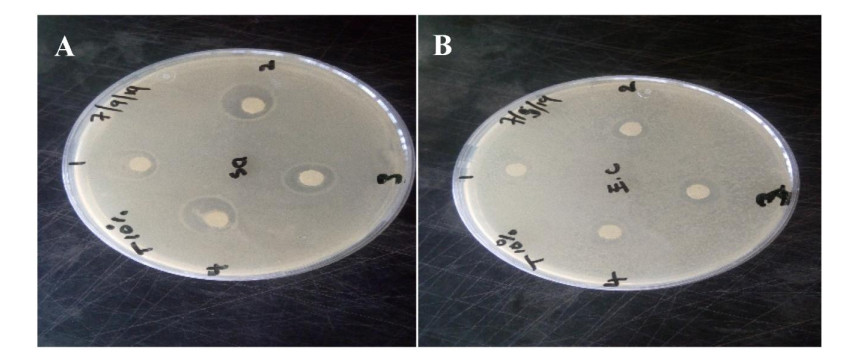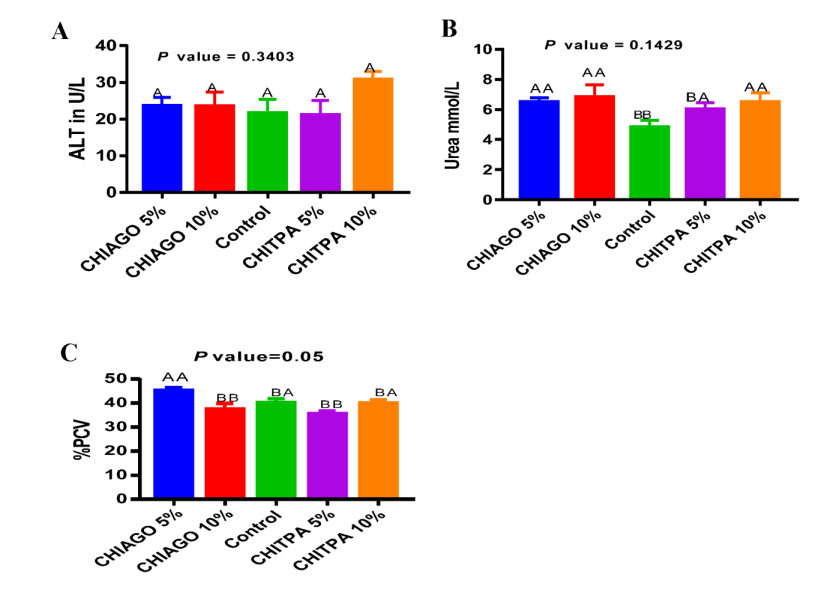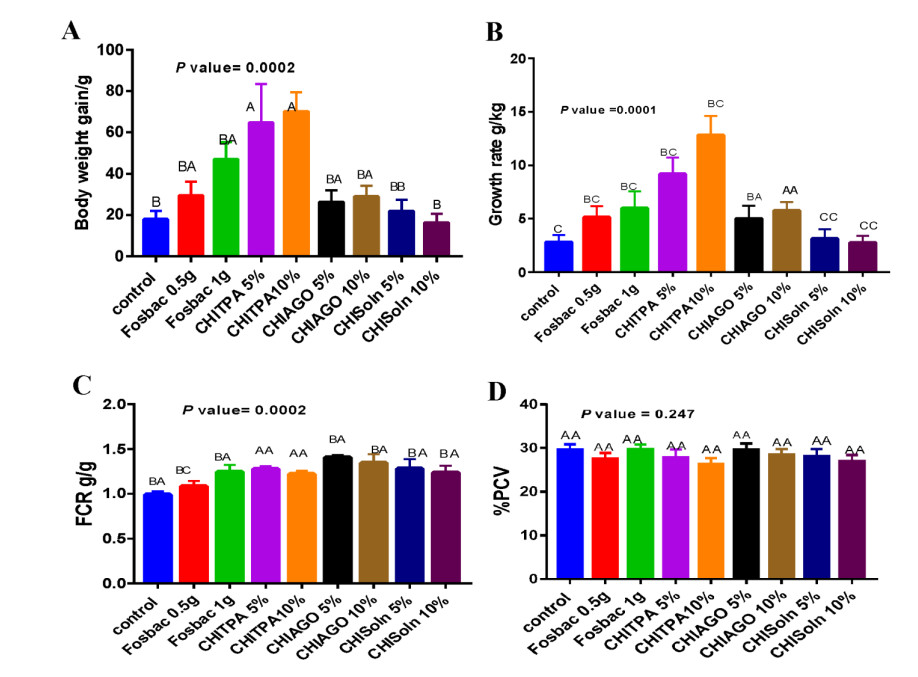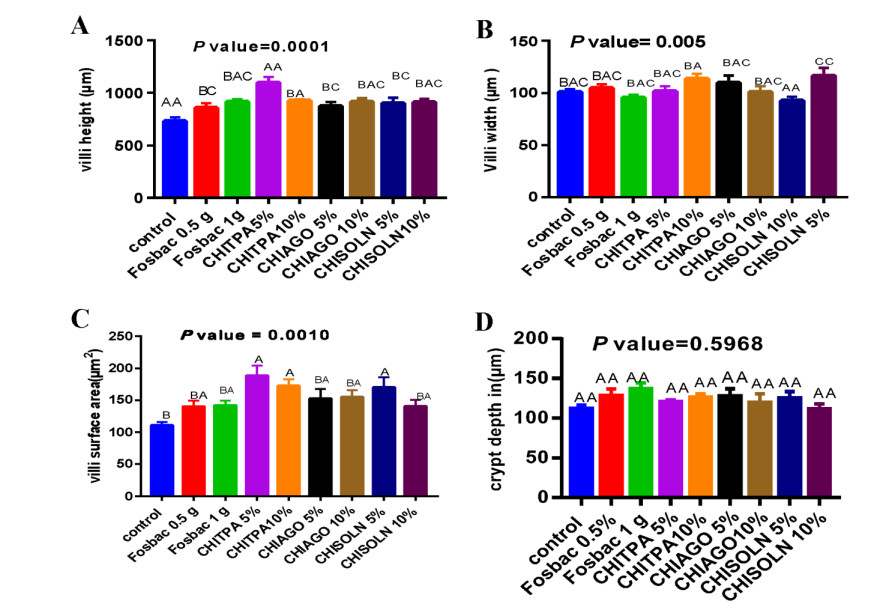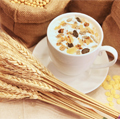Antibiotics in poultry as growth promoters have the perspective of products acceptability and human health concern. Plant extracts have been used as alternatives to antibiotics but dosage varies and reducing agents in the chicken gut in-activates most of the potential compounds. This research aimed to determine the antibacterial activity, acute toxicity in mice and the effect of Garlic and Onion Chitosan Nanoparticles on growth indices in Rainbow Rooster Chicken. Study involved two treatments, treatment 1 consisted of Chitosan Nanoparticles prepared from aqueous of Garlic (Allium sativum) and Onion (Allium cepa L.) (CHIAGO) whilst treatment 2 was Chitosan Nanoparticles prepared from total Phenol and Ajoene rich extract (CHITPA). Products were characterized by pH sensitivity, Fourier Transform Infrared Spectroscopy (FTIR) and Field Emission Scanning Electron Microscopy (SEM). Disc diffusion method was used to test for activity against Escherichia coli (E. coli) and Staphylococcus aureus (S. aureus) with Fosbac as the positive control. Acute toxicity in mice through oral administration of the nanoparticles solution at dosage of 5% and 10%. Nanoparticles and chitosan solution were administered orally to chicken at dosage of 5% and 10%. The treatments against E. coli gave resistance zone of inhibition (≤ 12), an intermediate zone of inhibition (13 to 15) while against S. aureus gave resistance zone of inhibition (≤ 12), an intermediate zone of inhibition (13 to 15) and susceptible zone of inhibition (≥ 16). Alanine aminotransferase and urea had no significant changes (p > 0.05) but significant differences in PCV in mice (p < 0.05). There was a significant increase (p < 0.05) in chicken’s body weight gain, growth rate, feed conversion ratio, villi height, width, and villi surface area with no significant increase (p > 0.05) observed in crypt depth and PCV% when compared with the contolled chicken. Garlic and Onion Chitosan Nanoparticles can act as alternative to antibiotics as growth promoters in poultry.
1.
Introduction
Resistance to antimicrobial agents and their residues in animal products are of human health concern [1], therefore, attempts have been made to replace these additives with herbs [2]. Use of antibiotics as feed additives is no longer acceptable and is prohibited in developed countries hence, developing substitute materials and strategies for improvement of animal growth and disease prevention are necessary. Plant extracts, spices as single or mixed compounds have been used in the promotion of performance and health condition of the animal [3]. Onion (Allium cepa L.) extracts have been reported to have antibacterial, antihypertensive, hypoglycemic, antithrombotic, antioxidant, antihyperlipidemic and anti-inflammatory properties [4] and it can be used as alternative to in-feed antibiotics for broiler diets [3]. Allicin and other active components of garlic (Allium sativum) have some positive effect for livestock, including hypocholesterolemic, growth promoting, antimicrobial and antioxidant effects [5]. The antimicrobial activities of garlic and onion have also been reported by Viera et al. [6] and their combination improves the feeding efficiency and body weight of chicken [7]. There are number of medicinal herbs been used as antimicrobial by scientist around the world with recently used extract of xylocarpus granatum as inhibitor of vibrio harveyi infection in shrimp [8]. Polyphenols when ingested are degraded in the gastrointestinal tract (GIT) before reaching blood [9]. The instability of most phytochemical in the in-vivo condition leads to the formation of stable products using nano-biotechnology for effective stability and bioavailability of the product [10]. Nanoparticles of smaller sizes have been prepared using chitosan polymers with the Ocimum basilicum leaf extract without any synthetic negatively charge materials [11]. Nanoparticles synthesis from plant extracts sources has some advantages over the conventional chemical synthesis method. The nanoparticles possess more permeability through the capillary walls and thereby, play an important role in targeted drug delivery and this process uses bio-degradable materials which ruled out the possibility of environmental accumulation and pollution due to chemicals [12]. The natural polymer chitosan is non-toxic, biodegradable, biocompatibility and bioavailability. The polymer is formed of N-acetyl D-glucosamine and D-glucosamine groups. Chitosan polymer has different molecular weight and it has many applications especially in the food industry and drug delivery [13]. Chitosan is a film forming, it has gelation properties and encapsulation potential such as hydrogen beads [10]. The nanoparticles sizes of less than 300 nm can reach the blood stream while, particles that are smaller than 100 mm can easily get into various tissues and organs [14]. Chitosan has been proven to have antimicrobial activities reported by many authors as such in-vivo [15]. Chitosan interact with the ionic component of bacteria surface i.e. negative charge lipopolysaccharides in the outer membrane of Gram-negative and peptidoglycan and teichoic acid on the surface Gram-positive bacteria [10]. Application of lower dosage of chitosan, can be used as an alternative to antibiotics as growth promoter to avoid antibiotics residues in animal products, reduce environmental contamination and produce pollution free animal products. The novel strategy of nanoparticles can be exploited in livestock and poultry nutrition for effective uptake of nutrients, better utilization of feedstuff and other supplements [16]. The objectives of this study was to determine antibacterial activities, acute toxicity and the effect of garlic and onion extract chitosan nanoparticles on the growth indices and villi morphology in rainbow rooster chicken. The treatments showed no toxicity effect in mice, with zones of inhibition in (E. coli) and (S. aureus), increased some of growth indices and villi micromorphology of Rainbow Rooster Chicken.
2.
Materials and methods
2.1. Study site
The production of the chitosan nanoparticles of garlic and onion and antibacterial activity tests were done at PAUSTI-Biotechnology Molecular Biology Laboratory in JKUAT-Kenya. The Acute toxicity in mice and chicken breeding was at JKUAT Safari Animal Facilities and Poultry Cages respectively. Histology slides preparation for jejunum was done at JKUAT histology laboratory.
2.2. Preparation of aqueous onion and garlic, total phenol and ajoene rich extracts
Onion (Allium cepa L.) and garlic (Allium sativum) were bought from a market in Juja in Kiembu County. Onion (red Creole orallium) and garlic (softneck) were identified by Botany Department in Jomo Kenyatta University of Agriculture and Technology, Nairobi, Kenya. The aqueous extract of garlic preparation was done according to the method described by Huzaifa [17] with modification, 50 g of Peeled bulbs of garlic was chopped, grounded, mixed with 500 ml distilled water, stored for 24 Hours, filtered the following day by filter paper (Whatman No. 1) and stored at 4℃ till used. The ajoene rich extract was prepared according to Viswanathan et al. [18] with modification, 50 g of peeled garlic bulbs was peeled, chopped and homogenously blended with cold distilled water of 500 ml, well stirred, filtered with cotton cloth, transferred into a new flask, ethyl acetate added, stirred and allowed to stabilize for separation of Ajoene rich extract. The upper layer was pipetted into a filter paper (Whatman No. 1) to remove all the water and collection of semi aqueous substance which is the ajoene rich extract hence, evaporation of ethyl acetate and the extracted product was stored at 4℃ till used. The preparation of aqueous extract of onion was done according to Oyebode and Fajilade [19] with some modification, the onion bulbs together with the outer part were clean with ethanol to remove dirt, chopped into small thin slices, air dried for 2 weeks and 50 g was weighed, 500 ml of distilled water added and heated at 72℃ for 3 Hrs and allowed to cool at room temperature and the extract was then filtered with filter paper (Whatman No. 1), then stored at 4℃ till utilization. Preparation of total phenol extract was done according to Mujic [20] with some modification, 50 g of chopped, air dried onion bulb soaked in 500 ml of 70% ethanol, left over night and filtered the following day by filter paper (Whatman No. 1) and the ethanol solvent was completely removed by rotary evaporator under vacuum at a temperature of 55℃ and the extract was stored at 4℃ till used.
2.3. Preparation of garlic and onion aqueous, total phenol and ajoene rich extracts chitosan nanoparticles
2.3.1. Preparation of chitosan solution
Chitosan solution was prepared as described by Rasaee et al. [11] with some modification. The Low molecular weight chitosan was purchased from Sigma Anderia, 2 g (w/v) was used with 0.5% (v/v) acetic acid and the pH of the solution was raised to 5 with 1 N NaOH under a magnetic stirring for 24 hours and topped to a volume of 200 ml with distilled water, stored at 4℃ till application.
2.3.2. Preparation of the chitosan nanoparticles
Preparation of chitosan nanoparticles was done through ionic gelation interaction between positive and negative charge compound as described by Rasaee et al. [11] with modification. Aqueous chitosan was prepared by mixing 40 ml of chitosan solution with 10 ml from the mixture of garlic and onion aqueous extract (CHIAGO) as treatment 1. A mixture of 10 ml of total phenol and homogenous ajoene rich extract with 40 ml chitosan solution was mixed (CHITPA) as treatment 2. The mixtures were stirred for 10 minutes at 60℃, centrifuged at 200 rpm and allowed to rest at room temperature for 30 minutes to form an opalescent solution.
2.3.3. Characterization of the chitosan nanoparticles
The nanoparticles prepared from aqueous of garlic and onion, total phenol and ajoene rich extract form a clear solution and after left for 30 minutes it formed an opalescent solution and the sample was stored at 4℃ till utilization. The prepared products were characterized by their sensitivity to pH according to Chatterjee [21] to confirm the formation of the nanoparticles, where pH was increased by addition of 300 μl of NaOH into 40 ml of distilled water in a solution of 1 ml of the nanoparticles leading to the formation of a cloudy solution of CHISOLN, CHIAGO and CHITPA showing a cloudy and brownish yellow color. The chitosan nanoparticles (solution form) prepared from garlic and onion extracts were also characterized by Fourier Transform Infrared Spectroscopy (FTIR) BRUKER ALPHA MODEL to identify the functional groups responsible for the formation of the chitosan nanoparticles of chitosan with the extracts of garlic and onion. Drop of the sample was picked by a capillary tube and placed in a clean KBr plate and an other plate was place over it to form a thin layer film, the plate was then placed in sample holder then into the machine. The spectral resolution was set at 4 cm-1 and scanning ranges from 300 cm-1 to 4000 cm-1. FTIR spectra peak of CHISOLN, CHIAGO and CHITPA were recorded, manifested and identified accordingly. The SEM analysis was done to confirm the morphology and the size of the nanoparticles prepared. The chitosan nanoparticles (solution form) were transfer in a cool box for the SEM characterization in Fribourg University Faculty of Science and Medicine, Germany. The morphological analysis was performed using Tescan Mira3 LM FE Scanning electron microscope operated at an accelerating voltage of 3kV. The samples were gold sputtered before observation to avoid the charging effect.
2.4. Determination of antimicrobial activity of chitosan nanoparticles
Antimicrobial activity of chitosan nanoparticles against E.coli and S. aureus was done by disc diffusion method, the disc was prepared 5mm from whatman filter paper and sterilized before used. Broth media of E.coli and S. aureus was diluted using normal saline and a cell suspension equal to a density of a 1 McFarland turbidity standard, Mueller-Hinton agar test was done in replicates for 5% and 10% from the treatments i.e. CHISOLN, (CHIAGO), (CHITPA) and 0.5 g and 1 g for Fosbac antibiotics. The plates were incubated at 37℃ overnight and the following morning, the zone of inhibition diameter in millimeters was measured with a ruler.
2.5. Determination of acute toxicity test of chitosan nanoparticles particles in Mice
Thirty BALB/c male mice was used to test for acute toxicity of garlic and onion Chitosan nanoparticles, the mice were divided into five groups of control thus; Chitosan nanoparticles with aqueous of garlic and onion (CHIAGO) and Chitosan solution with total phenol and ajoene rich extract (CHITPA) through oral administration of 5% and 10% and a control group. Biochemical analysis was done for the ALT and Urea using standard diagnostic test kits on automated clinical Biochemistry analyzer (Reflation Plus System®, MODEL: Cobas Analyzer India) and the biochemical results, PCV were compared with the normal ranges of BALB/c mice, Kifayatullah et al. [22] and Santos et al. [23]. PCV values for mice were determined by Hawksley micro-hematocrit reader, model 2948965. The acute toxicity of the nanoparticles test in mice was done for a period of two weeks. Mice were divided into five groups, of six mice group. The behavior of the mice towards water with chitosan nanoparticles additive and feed intake was monitored. Further, monitoring of movement, fur appearance, droplets from eye, nose and ear was recorded. After two weeks, mice were sacrificed and blood taken for serum separation and PCV measurement.
2.6. Determination of effect of garlic and onion chitosan nanoparticles on some growth indices and villi morphology in Rainbow Rooster Chicken
2.6.1. Husbandry, diets and experimental design and sampling
A total of 180 mixed population of indigenous Rainbow Rooster Chicken aged 8 weeks from Kukuchic Company were reared on wooden cages at JKUAT Safari animal facility for a period of 8 weeks. Nine chickens were placed in one treatment set with three chickens per cage. The four treatments with 5% and 10% of CHISOLN, CHIAGO, CHITPA and 0.5 g, 1 g of Fosbac and controls were placed in two opposite blocks. Food was provided ad libitum for both controlled and water treated groups; the chickens were fed on Kienyeji grower mash produced from the commercial feed company (First Animal Feed). The chickens were acclimatized for two weeks as adaptation period, followed by oral administration of the treatments (twice a week) for 8 weeks. Some of Growth performance indices (body weight gain, growth rate, feed conversion ration) were recorded on weekly basis and two chickens from each treatments and controls sacrificed by cervical dislocation according to Laudadio et al.
[24]. The weekly sacrifice run through 8 weeks in which, blood samples were taken for serum separation, PCV analysis, and Jejunum sample was taken and preserved in 10% formalin.
2.6.2. Characterization of villi morphology of Rainbow Rooster Chicken
Histological slides were prepared, slides photos 10x images and Imagej 1.5a version was used to measure the villi height, width and crypt depth of jejunum. The surface area of jejunum villi was calculated using the below formula:
Where π = 3.14, VW = villus width and VH = villus height, according to Sakamoto et al. [25].
2.7. Statistical analysis
Graphpad Statistical Package version 7.1 was used to draw graphs and all data were analyzed statistically using Tukey mean differences in Statistical Analysis System (SAS) statistical software version 9.1. Differences were considered statistically significant (p ≤ 0.05).
3.
Results
3.1. Characterization of nanoparticles
3.1.1. PH sensitivity
PH sensitivity was tested by the addition of 1 ml of chitosan nanoparticles into 40 ml of distilled water did not form a precipitate of chitosan (Figure 1A). Addition of 300 μl of 1 mol NaOH changed the pH from 4 to 8 (Figure 1B and 1C) led to formation of precipitate of chitosan (a cloudy solution of CHISOLN), CHIAGO and CHITPA in Figure 1C formed cloudy and color changed to brownish yellow.
3.1.2. FTIR characterization of the chitosan solution and chitosan nanoparticles
Fourier Transform Infrared Spectroscopy (FTIR) Characterization of CHISOLN, CHIAGO and CHITPA in Figure 2. showed the OH-1 functional group of chitosan at 3421.72319 cm-1, -COOH at 2083.68469 and amino group at 1630.797443 cm-1. FTIR of Chitosan Nanoparticles Aqueous extract of Garlic and Onion (CHIAGO) with peaks at around 3390.3758 indicated the combined peak of NH2 and OH-1 groups stretched vibration in chitosan, peaks at 2072.96059 is the combined NH2 and -COOH stretched vibration and peak at 1630.79743 is NH2 bend. FTIR of Chitosan Nanoparticles with total Phenol and Ajoene rich extract (CHITPA) showed peaks at 3401.5912 indicated the combined peak NH2 and OH-1 stretched vibration in chitosan, NH2 and -COOH stretched at 2063.06141 and NH2 bend at 1630.7974.
3.1.3. Field emission scanning electron microscope (SEM) characterization
Characterization of chitosan nanoparticles of garlic and onion extracts by SEM showed chitosan of aqueous extract from garlic & onion with well rod-like shape particles in Figure 3. Figure 4 showed chitosan with total phenols and ajoene extract from garlic & onion showed nanoparticles spherical shape with agammaegation.
3.2. Antibacterial activities of garlic and onion chitosan nanoparticles against E. coli and S. aureus
Garlic and onion chitosan nanoparticles antibacterial activities showed in Table 1, were tested against E. coli and S. aureus by disc diffusion (Figure 5) and it showed no significant differences (p > 0.05). The bacteria among the treatments showed susceptibility, intermediate and resistance inhibition zone when comparing with Clinical Laboratory Standard Institution [26] for Fosfomycin. CHISOLN 5%, CHISOLN 10%, Fosbac 0.5 g, CHITPA 5%, CHITPA 10% had resistant inhibition zone, Fosbac 1 g, CHIAGO 5%, CHIAGO 10% had an intermediate inhibition zone against E. coli. CHISOLN 5%, CHISOLN 10%, CHITPA 5% had resistant inhibition zone, Fosbac 0.5 g, Fosbac 1 g, CHIAGO 5%, CHITPA 10% had an intermediate inhibition zone and CHIAGO 10% had an susceptible inhibition zone against S. aureus.
3.3. Acute toxicity of garlic and onion chitosan nanoparticles in Mice
Acute toxicity study of the nanoparticles was performed by biochemical test kit and, ALT and Urea (Figure 6A and 6B) showed no significant difference among the means and the control (p > 0.05). PCV (Figure 6C) showed differences among the means and the control (p < 0.05).
3.4. Effect of garlic and onion chitosan nanoparticles in growth indices in Rainbow Rooster Chicken growth
Some of growth indices parameters were measured after oral administration of the nanoparticles prepared for 8 weeks in Rainbow Rooster Chicken; indicated significant diffferences among the means in comparison to the control when analyzed.The body weight gain in Figure 7A; growth rate in Figure 7B; feed conversion ratio in Figure 7C showed significant difference among the means and the control (p < 0.05). Pack Cell Volume in Figure 7D showed no statistical significant differences among the treatment when compared with the control (p > 0.05).
3.5. Morphological characterization of jejunum villi following administration of garlic and onion chitosan nanoparticles in rainbow rooster chicken
After oral administration of the Chitosan nanoparticels for 8 weeks to Rainbow Rooster Chicken, the mean in Jejunum villi; height in Figure 8A, width in Figure 8B and villi surface area in Figure 8C showed a significant difference and increase among the treatments compared to the control (p < 0.05). Crypt depth in Figure 8D had shown no significant differences (p > 0.05) when compared to the control.
3.6. Ethical approval
This research work was approved by Jomo Kenyatta University of Agriculture and Technology (JKUAT) ethical review board vide ethical approval number REF: JKU/2/4/896B.
4.
Discussion
4.1. Characterization of the chitosan nanoparticles
4.1.1. PH sensitivity
Addition of 300 μl NaOH into water containing nanoparticles led to change in pH from 4 to 8 and forming precipitate of chitosan with rise in pH and a cloudy solution of CHISOLN, CHIAGO and CHITPA formed brownish yellow color. The absorption of color depends on the protonated amino group of chitosan in acidic media and can attract with negative ion dye as reported by Iqbal [27], the color released when pH increases. The precipitate of chitosan nanoparticles after the addition of NaOH correlates with other studies (Silva et al. [28], Wahba [29] and Chatterjee [21]).Chitosan Nanoparticles were stable in weak acid, similar to what was reported by Andrew et al. [30].
4.1.2. FTIR
The FTIR findings agreed with the reports by John Coates [31]. The decrease in the spectrums of Chitosan solution with aqueous extract of garlic and onion (CHIAGO) and Chitosan nanoparticles prepared with total phenols and ajoene rich extract (CHITPA) when compared with chitosan solution (CHISOLN) spectrum indicated the formation of chitosan nanoparticles, as reported by Saharan [32], shifting of vibration from higher to lower wave number reveals the formation of chitosan nanoparticles.
4.1.3. SEM
SEM results show that CHIAGO anoparticles were well separated, with rod-like shape. Chitosan with total Phenol and Ajoene (CHITPA), showed nanoparticles of microagammaegates consisting of small particles of spherical shape which is also comparable with Esquivel et al. [33] who indicated increase in pH forming micro-agammaegation with high hydrogen concentration compared to the chitosan amine.
4.2. Antimicrobial activity of chitosan nanoparticles
Garlic and onion chitosan nanoparticles indicated no significant differences (p > 0.05) for S.aureus and E. coli, respectively among the treatments. Results showed susceptibility, intermediate and resistance inhibition zone among the treatments when compared with Clinical Laboratory Standard Institution [26] for Fosfomycin. CHISOLN 5%, CHISOLN 10%, Fosbac 0.5 g, CHITPA 5%, CHITPA 10% had resistant inhibition zone, Fosbac 1 g, CHIAGO 5%, CHIAGO 10% had an intermediate inhibition zone against E. coli. CHISOLN 5%, CHISOLN 10%, CHITPA 5% had resistant inhibition zone, Fosbac 0.5 g, Fosbac 1 g, CHIAGO 5%, CHITPA 10% with an intermediate inhibition zone and CHIAGO 10% had an susceptible inhibition zone against S. aureus. Chitosan Nanoparticles preparation activities against S.aureus and E. coli, the results are comparable with the findings by Tomy [10] who stated that, Chitosan with the polyatomic behavior in an acidic medium contributes to antibacterial activity and under acidic condition, the positive charge of chitosan interact with anionic components on the surface of bacteria, the lipolysaccharides in the outer membrane Gram-negatives bacteria and peptidoglycan and teichoic acid in Gram-positive, this electrostatic interaction with bacteria result to the release of most proteinaceous material from the cell.
4.3. Acute toxicity of chitosan nanoparticles in Mice
Acute toxicity of the nanoparticles biochemical results for ALT and Urea showed no significant difference among the means and the control (p > 0.05). PCV showed differences among the means and the control (p < 0.05). Garlic and Onion nanoparticles do not have any effect in biochemical parameters and PCV in mice when compared with Kifayatullah et al. [22] and Santos et al. [23].
4.4. Effect of garlic and onion chitosan nanoparticles in growth indices parameters in Rainbow Rooster Chicken
The nanoparticles prepared from the extracts of garlic and onion showed a significant increase in chicken (p < 0.05) in the body weight gain, growth rate and feed conversion ratio when compared with the control whilst, there is no significant differences for the Packed cell volume among the treatments compared with control (p > 0.05) in rainbow rooster chicken. The findings are similar to reports by AL-Ramamneh [7], who indicated the combination of garlic and onion for improved chicken performance, feeding efficiency and body weight. Andi et al. [34] showed improvement in some of the performance parameters such as feed intake, weight gain and feed efficiency of broilers fed on nanoparticles due to the influence of ioinic silver on the intestinal of harmful bactetria [35], it improves the gut’s health and consequently leads to better nutrients absorption. Nuengjamnong & Angkanaporn [36] has reported chitosan significantly improved feed conversion ratio (FCR). Garlic powder also increases body weight, body weight gain [37].
4.5. Morphological characterization of jejunum villi following administration of garlic and onion chitosan nanoparticles in Rainbow Rooster Chicken
Among the treatments, chitosan nanoparticles also indicated a significant improvement in villi height (VH), width and villi surface area (p < 0.05) whilst none significant difference for crypt depth (p > 0.05) hence correlates with Nuengjamnong & Angkanaporn [36], indicated an increase in the ratio of villus height (VH) and crypt depth (CD) whilst decrease in the CD. The Villus height/Crypt depth is a useful tool in the evaluation of nutrient absorption potential and the epithelial cell turnover in the small intestine [38]. Garlic powder elongated villi which increases nutrient surface area for nutrient obsorption whilst small crypt lowers both tissues turnover and the demand for new tissue [37].
5.
Conclusion
Garlic and onion aqueous extract can form stable chitosan nanoparticles with antibacterial activity against S. aureus and E. coli similar to fosfomycin and it could act as alternative. The nanoparticles have no effect in the biochemical parameters and PCV in mice and increases chicken’s body weight gain, growth rate, feed conversion ratio, villi heigth, width, and surface area but without change in crypt depth and PCV% when compared with the control rainbow rooster chicken thus; can be used as alternative to antibiotics as growth promoter.
Authors contributions
Viviana Imbua Levi Enoka, participated in conceptualizing the study, drafting the proposal, laboratory experiments, data collection, analysis and interpretation of the findings and drafting of the manuscript. Gideon Mutie Kikuvi participated in reviewing and editing the research proposal, guided the laboratory analysis, interpretation of the findings and reviewing of the manuscript. Perpetual Wangui Ndung’u participated in reviewing and editing the research proposal, guided the laboratory analysis, interpretation of the findings and reviewing of the manuscript. All the authors approved the manuscript.
Acknowledgements
This research is funded by Pan Africa University, Institute of Basic Sciences, Technology and Innovation. Management of PAUSTI for funding the study, PAUSTI and JKUAT for the provision of research facilities and conducive work environment and above all, allocation of high profile supervisors for academic guidance. My dear colleagues, Laborartory technicians and support staff for their enormous contribution in making this study a reality.
Conflict of interest
No conflict of interest is associated with the study and all parties contacted expressed their free and open respond for all types of data required without restriction and return.










 DownLoad:
DownLoad:
